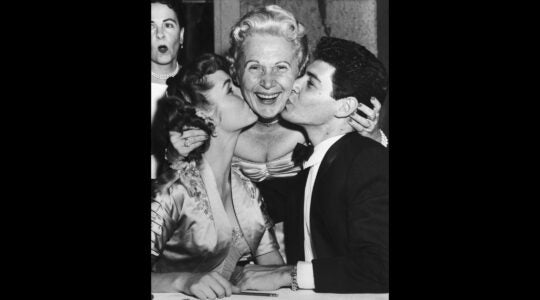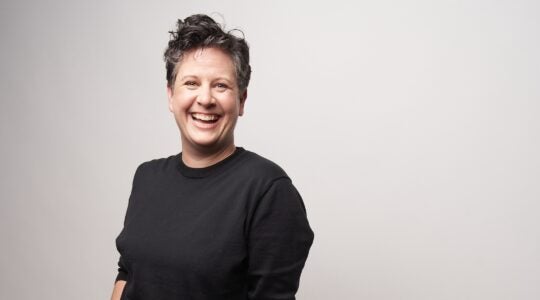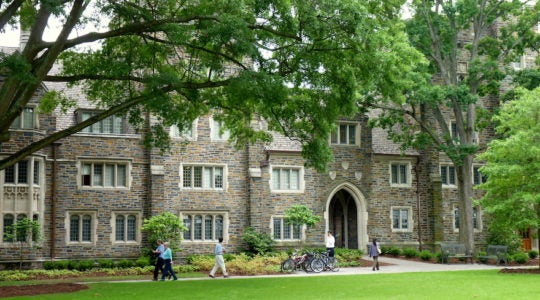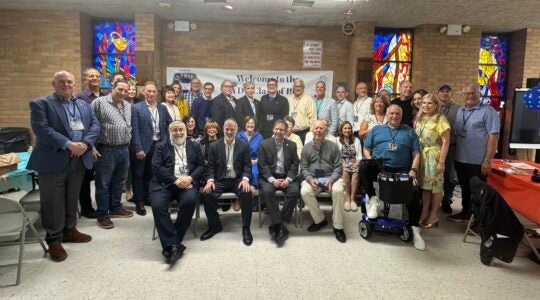A 9-year-old yeshiva student from Borough Park, Yaakov Dovid takes dance lessons. But he’s not learning the hora or traditional Jewish line dances.
Like the b-boys and girls in the subway corridors who mix dance and gymnastics, and then pass the hat around, Yaakov is learning how to pop, lock, spin and flip.
Welcome to the world of haredi hip-hop, in the heart of Orthodox Brooklyn.
Walk through the back entrance and down the steps of an inconspicuous residence on East 34th Street between Avenues J and K, and find one of the best-kept secrets in Flatbush: the one-room dance studio that houses the Brooklyn Jewish Dance Institute. Mirrors cover the walls, and the dancers test out their moves on a neatly paneled wood floor. A boom box sits in the front of the room, pounding out hip-hop rhythms — minus the often-racy lyrics.
It’s a recent Tuesday night, and the Advanced Boys Class is taking place inside. The boys, kipas on their heads and sidelocks flying, step and jump in unison to the pulsating beat.
“Yes, that’s right, frum boys dancing,” said Rivka Nahari, sitting in the waiting area outside the dance studio, the reverberating bass from the music inside punctuating her words.
Nahari, a professionally trained musician and flamenco dancer, opened the institute in her home in 2008. Given its fervently Orthodox inclinations, the institute provides separate dance classes for girls and boys from Brooklyn’s yeshivish and chasidish communities. Students range in age from 3 to late teens; the institute even provides select classes for adults. Girls take ballet, jazz, tap and hip-hop. Boys’ classes, which Nahari began offering a couple of years ago, feature break dancing and hip-hop, referred to on the website as “pop and lock.”
“Even though what I’m doing is viewed suspiciously by much of the right-wing world, I haven’t let that discourage me,” Nahari said. “I did not open this studio to make a statement. I opened this institute because I wanted to bring movement, joy and body consciousness to the frum Jewish world. There’s no type of dance that can’t be adjusted for a kosher environment.”
Nahari, who has been dancing since the age of 3, didn’t grow up in a strictly “kosher” environment. Raised in Las Vegas, she studied in the pre-professional program at the Academy of Nevada Dance Theater, where she continued until graduating from high school. She began to explore her Jewish roots at 14, when Chabad Lubavitch set up a branch in Las Vegas. “I wasn’t willing to compromise the quality of the arts because I had chosen a religious life,” said Nahari. “I didn’t have to.”
Eli Raul, 11, has been “boyoing” (slang for break-dancing) for three years. Studying Talmud for many hours in school each day, Eli cuts loose on Tuesday nights, when he participates in the Advanced Boys Class. It’s the highlight of his week. “Everyone in school knows that I dance now,” Eli said. “Some don’t really understand, but most thinks it’s cool.”
Favorite move? “My flip-up,” he said, smile spreading. “I always go to the center of circles at bar mitzvahs and weddings, to show what I’ve learned.” And, most importantly: How do you keep your kipa on while you’re doing a head spin? “Clips,” said Eli.
For some families, the dance classes have proved very beneficial.
“A lot of people from the community still don’t understand why I signed up my son for dance classes,” said Tzippy Klein, 25, from Borough Park. Her son, Shimon, 6, having just finished his class, sat nearby in striped shirt, casual sneakers and a velvet kipa. His mother reports that before he started to take lessons, Shimon was having significant difficulty in class. “He couldn’t sit still, couldn’t concentrate. The teacher kept sending him to the resource room,” said Klein. “But I know my son. He’s a bright kid. What he needed wasn’t the resource room. He needed an outlet.”
Klein described how the dance classes have been “transformative” for her son. “Shimmy’s back to being at the top of the class. He can sit for two hours doing kriah [a methodical reading of Talmudic texts], when before you couldn’t keep him still.” And now, all of sudden, his friends’ mothers are curious.
Dance hasn’t only been helpful for academics. The mother of one of the boys shared how her son had been bullied terribly in school — until he started to dance. “He’s the shortest in his group of friends, and the boys used to tease him and pick on him. After he started to dance, he gained a whole new level of confidence,” she said, nodding as she spoke. “Now, he’s one of the guys. Dance has earned him respect.”
Despite a growing acceptance for what she is doing, Nahari has met with resistance from day one. When she first wanted to start the dance studio, she brought the idea before a panel of six rabbis from Flatbush, hoping to have the project sanctioned. The rabbis were not enthusiastic.
“They told me, ‘You can’t do this.’ It was right before Rosh HaShanah — they gave me quite the guilt trip.” Two rabbis, however, who were not part of the panel, gave her independent support, termed a haskama in the haredi world. Asked for their names, Nahari declined to provide them. “If someone is curious about what I’m doing, they can call and I’ll let them know I have haskama from reliable sources. I put that disclaimer on all my ads.”
As for her next steps, Nahari is thinking big. She hopes to create a professional dance company for her students. “I’m tired of people asking, ‘What’s the point of dance if they have nothing to do with it?’” said Nahari. “A dance company would allow students a way to continue dancing, within the community. Many parents are scared that their daughters — or sons — will fall in love with dance and leave the community.”
Practically, the dance company would be all female. Has anyone approached her with serious interest in the idea so far? “Well, no. By the age that these young women might be involved, most of them are getting married and having babies,” said Nahari.
In order to maintain quality control, Nahari hires only teachers with many years of professional training. None of them are Jewish.
Richard Santiago, her boys’ break-dancing teacher, goes by the street name “Break Easy.” In sweatpants and a tank top, with arms like two small tree trunks, he makes quite a contrast to his gangling preteen students, who wear collared shirts (albeit casual) with tzitzit hanging out. Santiago has been dancing, on the street and off, for more than 30 years. He teaches dozens of students, at dance centers across New York.
This is, however, his only Jewish class. “I’ve watched these kids develop and become more comfortable in their own skin,” said Santiago. “I teach body movement — the dance comes out of them.”
Is there anything different about teaching an exclusively Jewish class? “Nah,” said Santiago, laughing. “Boys are gonna’ be boys. They’re competitive amongst themselves, always trying to see who can break a new move first. Question is — who can be faster, funnier, more dynamic in character.”
After a moment of reflection, he continued, “One thing’s different about teaching Jewish kids. None of my other students are going to be busting these moves at bar mitzvahs!
“You know what would be beautiful?” Santiago continued. “If, at one point, the ladies and the men could witness each other’s expression through dance together.” He stopped short, with a bemused expression. “But I don’t think that will happen for a while.”
The New York Jewish Week brings you the stories behind the headlines, keeping you connected to Jewish life in New York. Help sustain the reporting you trust by donating today.




